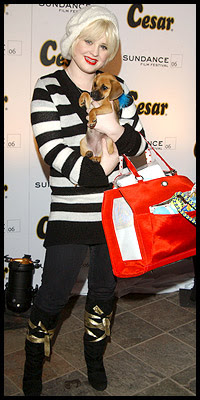
Looks like the 'Desperate Housewives' star Eva Longoria is about to take this lucky Pomeranian pup on a shopping spree.
The Pomeranian is a breed of dog in the spitz family, named for the Pomerania region of Historical Eastern Germany, which is today part of northern Poland and part of modern eastern Germany, and classed as a toy dog breed because of its small size. As determined by the FCI the Pomeranian is part of the German Spitz breed, and in German and many foreign speaking countries known as the the Zwergspitz, or Toy German Spitz.
Appearance of a Pomeranian
At an average of 3 to 7 lb (1.4 to 3.2 kg) according to AKC standards, the Pomeranian (Pom) is the most diminutive of the northern breeds.
The head of the Pomeranian is wedge-shaped, making it somewhat foxy in appearance. The ears are small and set high. Its tail is characteristic of the breed and should be turned over the back and carried flat, set high. When born, the tail is not spread out; it may take months for it to grow over the Pomeranian's back, and flatten. Beneath the Pomeranian's fur is a small but muscular dog, similar in appearance to a Chihuahua (dog).
The Pom's coat is its glory, two coats, an undercoat and a top coat; the first is soft, thick, and fluffy; the latter is long, straight and coarse. The undercoat is shed once a year by males, by intact females when they are in season, after delivering a litter, and during times of stress.
The AKC recognizes thirteen colors or color combinations: black, black & tan, blue, blue & tan, chocolate, chocolate & tan, cream, cream sable, orange, orange sable, red, red sable, and sable. The dogs that have 2 or more colors (usually mostly white, with others), are called "Parti-Color".
The AKC also recognizes five "alternative" colors: Beaver, brindle, chocolate sable, white, and wolf sable.
One breed standard calls for a cobby, balanced dog. A cobby dog is as long or shorter than it is tall; try to picture it as a circle in a square. A balanced Pomeranian fits together logically and in proportion. For instance, a small, delicately boned Pom with a large head looks unbalanced because its head type doesn't match its body type. A balanced Pom displays legs in proportion to its body: neither so short as to make him appear dumpy nor so long as to make it look like he is walking on stilts.
This standard also calls for an expression that imparts great intelligence, showing that the Pom has an alert character and that he behaves accordingly. The Pom's alertness makes it a superb watchdog, and a great companion, However they are very feisty and stubborn at times (they need a lot of attention).
Temperament of a Pomeranian
The Pomeranian is a very active dog who is intelligent, courageous, and a loyal companion. Pomeranians enjoy walking, and are fit for apartment life. They can be trained to be good watchdogs. The Pomeranian is confident, commanding, and outgoing. Due to the Pomeranian's small stature, they are not recommended for homes with small children as they may become temperamental. They make excellent watch dogs and will sound a bark when they sense danger.The Pomeranian is lively and eager to learn. They get along well with other household pets if given a slow and proper introduction. They make wonderful companions for families with older, well-behaved children and the elderly. The Pomeranian is a very sweet dog who adores spending time on laps or running around. Though sweet, they have lots of attitude.
Health of a Pomeranian
Pomeranians are generally a healthy, hardy, and long-lived breed. Poms often live 12–16 years. Some very healthy Poms have even been known to live 18-20 years.
The most common problem in Pomeranians is luxating patella. Also Legg-Calvé-Perthes syndrome and hip dysplasia can occur, but are rare in this small breed. Patent ductus arteriosus (a congenital heart defect) and collapsing trachea have become serious problems in Poms.
Dry eye, tear duct disorders and cataracts that can appear in young adulthood and often lead to blindness are also common. Skin diseases are quite common, especially allergies (that often leads to acute moist dermatitis or "hot spots") and follicular dysplasia (also known as alopecia X). Other problems that occur regularly include hypothyroidism, epilepsy, and hypoglycemia. Occasionally, hydrocephalus can occur in Pom puppies. Poms, like many Toy breeds, are prone to bad teeth and harmless episodes of reverse sneezing. Also, it is important Poms are trained not to mingle around peoples feet. Because of their loyal tendencies, they will follow from room to room, easily getting stepped on. Their delicate bodies will injure easily this way.
Grooming of a Pomeranian
Coat care for the Pomeranian is similar to the Pekingese. A daily or twice weekly (damp) brushing against the hair weekly is essential to keep the thick, plush coat, which sheds seasonally, free of mats. Brushing also helps to prevent dry skin and dandruff. A Pomeranian's coat needs very little trimming only every now and then. Combing is seldom necessary and sometimes totally unnecessary. Regular ear and nail care is recommended, along with peak seasonal bathing. However, it is unadvisable to bathe Pomeranians too frequently, as excessive bathing can damage their skin and coat by removing essential oils, especially if using anti flea products. Pomeranians are also prone to teeth problems, and it is recommended that their teeth be brushed at least once a week. Ideally, their teeth should be brushed daily and receive dental and vitamin treats.

